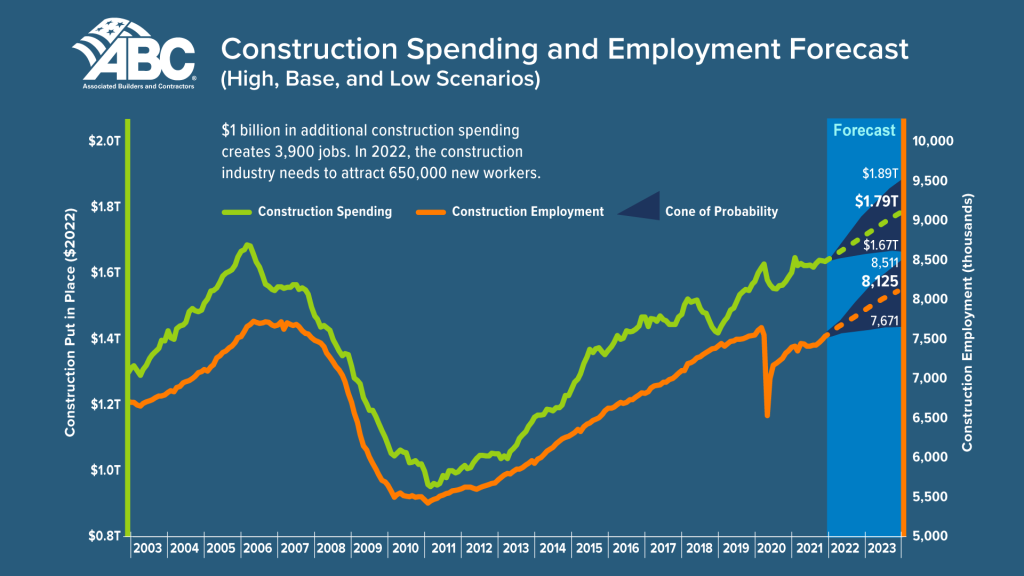For the past two-plus years, facilities professionals have been struggling with COVID, the Great Resignation, and supply chain issues, leading to a lack of materials and major delays on facility retrofits and new-construction projects across the country. Although such problems were expected to continue in 2022, a new report from the Associated Builders and Contractors (ABC) confirms it will likely remain difficult to find builders while the construction industry faces a big worker shortage of its own this year.

According to a model developed by ABC, the U.S. construction industry will need to attract nearly 650,000 additional workers on top of the normal pace of hiring in 2022 to meet the demand for labor.
“ABC’s 2022 workforce shortage analysis sends a message loud and clear: The construction industry desperately needs qualified, skilled craft professionals to build America,” said Michael Bellaman, ABC president and CEO. “The Infrastructure Investment and Jobs Act passed in November and stimulus from COVID-19 relief will pump billions in new spending into our nation’s most critical infrastructure, and qualified craft professionals are essential to efficiently modernize roads, bridges, energy production, and other projects across the country. More regulations and less worker freedom make it harder to fill these jobs.”
ABC’s proprietary model uses the historical relationship between inflation-adjusted construction spending growth, sourced from the U.S. Census Bureau’s Value of Construction Put in Place survey, and payroll construction employment, sourced from the U.S. Bureau of Labor Statistics, to convert anticipated increases in construction outlays into demand for construction labor at a rate of approximately 3,900 new jobs per billion dollars of additional construction spending. This increased demand is added to the current level of above-average job openings. Projected industry retirements, shifts to other industries and other forms of anticipated separation are also factored into the model.
Based on historical Census Bureau Job-to-Job flow data, an estimated 1.2 million construction workers will leave their jobs to work in other industries in 2022. It is expected that this will be offset by an anticipated 1.3 million workers who will leave other industries to work in construction.

“The workforce shortage is the most acute challenge facing the construction industry despite sluggish spending growth,” said ABC Chief Economist Anirban Basu. “After accounting for inflation, construction spending has likely fallen over the past 12 months. As outlays from the infrastructure bill increase, construction spending will expand, exacerbating the chasm between supply and demand for labor.
“An added concern is the decline in the number of construction workers ages 25-54, which fell 8% over the past decade. Meanwhile, the share of older workers exiting the workforce soared,” said Basu. “According to the Centers for Disease Control and Prevention, the industry’s average age of retirement is 61, and more than 1 in 5 construction workers are currently older than 55.
“The scarcity of qualified skilled workers is an even more pressing issue,” said Basu. “Since 2011, the number of entry-level construction laborers has increased 72.8%, while the number of total construction workers is up just 24.7%. For reference, the number of electricians was up 23.9% over that span while the number of carpenters actually declined 7.5%. The number of construction managers has increased by just 2.1%. More than 40% of construction workforce growth over the past decade is comprised of low-skilled construction laborers, who represent just 19% of the workforce.
“The roughly 650,000 workers needed must quickly acquire specialized skills,” said Basu. “With many industries outside of construction also competing for increasingly scarce labor, the industry must take drastic steps to ensure future workforce demands are met.”
In 2023, the industry will need to bring in nearly 590,000 new workers on top of normal hiring to meet industry demand, and that’s presuming that construction spending growth slows next year, according to ABC.
